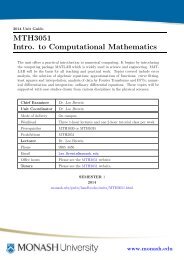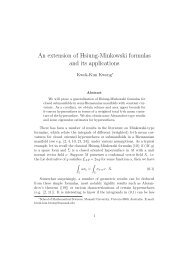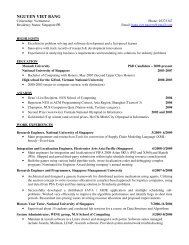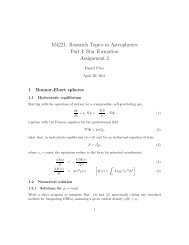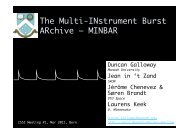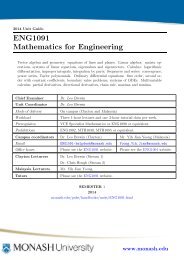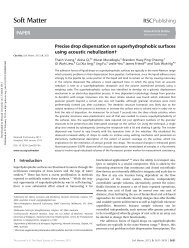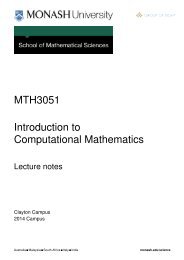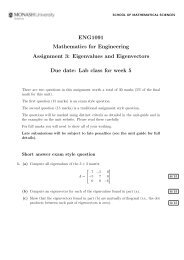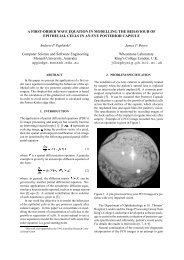12 1. A gentle introducti<strong>on</strong> to <strong>moduli</strong> <strong>spaces</strong> <strong>of</strong> <strong>curves</strong>Admittedly, the definiti<strong>on</strong> <strong>of</strong> a Deligne–Mumford stack is rather technical. To presentit here would take us too far afield from our goal and may even obscure the geometricnature <strong>of</strong> <strong>moduli</strong> <strong>spaces</strong>. However, <strong>on</strong>e will not go too far wr<strong>on</strong>g thinking <strong>of</strong> a smoothDeligne–Mumford stack as a complex orbifold. The stack structure takes care <strong>of</strong> the extrabookkeeping required to deal with <strong>curves</strong> with n<strong>on</strong>-trivial automorphisms. Essentially,this will allow us to treat the <strong>moduli</strong> space as smooth and ensure that there is a universalfamily over it. The reader interested in discovering more <strong>on</strong> stacks is encouraged toc<strong>on</strong>sult [14] and the references c<strong>on</strong>tained therein.Those troublesome <strong>curves</strong> with n<strong>on</strong>-trivial automorphisms have led us to c<strong>on</strong>sider <strong>moduli</strong>stacks <strong>of</strong> pointed <strong>curves</strong>. However, there is still <strong>on</strong>e outstanding issue which needs to be addressed— M g,n is not compact. To see this, observe that when two marked points <strong>on</strong> a pointedcurve approach each other, then the corresp<strong>on</strong>ding limit does not exist in M g,n . Of course, thereare numerous advantages in working with a compact space. And although there are variousways to compactify the <strong>moduli</strong> space, it is becoming increasingly clear that the most pr<strong>of</strong>itableis to use what is known as the Deligne–Mumford compactificati<strong>on</strong>. One <strong>of</strong> its virtues is that itis modular — in other words, it is a <strong>moduli</strong> space for a well-behaved, easy to describe, class <strong>of</strong><strong>curves</strong>. In fact, all we need to do is gently relax our smoothness c<strong>on</strong>diti<strong>on</strong>. Thus, we define theDeligne–Mumford compactificati<strong>on</strong> <strong>of</strong> the <strong>moduli</strong> space{M g,n = (C, p 1 , p 2 , . . . , p n )∣}/C is a stable algebraic curve <strong>of</strong> genus g with∼n distinct smooth points p 1 , p 2 , . . . , p nwhere (C, p 1 , p 2 , . . . , p n ) ∼ (D, q 1 , q 2 , . . . , q n ) if and <strong>on</strong>ly if there exists an isomorphism from Cto D which sends p k to q k for all k. Here, an algebraic curve is called stable if it has at worstnodal singularities and a finite automorphism group. The practical interpretati<strong>on</strong> <strong>of</strong> this latterc<strong>on</strong>diti<strong>on</strong> is that every rati<strong>on</strong>al comp<strong>on</strong>ent <strong>of</strong> the curve must have at least three special points,where a special point refers to a node or a marked point. It should be clear that M g,n ⊆ M g,n ,and we refer to M g,n \ M g,n as the boundary divisor. Theorem 1.1 can be extended to thecompactificati<strong>on</strong> as follows.Theorem 1.2. There exists a finite cover ˜M g,n → M g,n such that ˜M g,n is a smooth manifold. Furthermore,the boundary divisor lifts to a uni<strong>on</strong> <strong>of</strong> codimensi<strong>on</strong> two submanifolds intersecting transversally.The questi<strong>on</strong> still remains as to which curve arises in the limit when two marked points approacheach other. To see what the correct answer should be, c<strong>on</strong>sider a family <strong>of</strong> genus g<strong>curves</strong> with n marked points φ : X → B, where B is smooth and <strong>of</strong> complex dimensi<strong>on</strong> 1. Themarked points give rise to n secti<strong>on</strong>s which we denote by σ 1 , σ 2 , . . . , σ n : B → X. Supposethat all fibres are stable pointed <strong>curves</strong> apart from over the point b where the secti<strong>on</strong>s σ i andσ j intersect. In order to obtain a family <strong>of</strong> stable <strong>curves</strong>, <strong>on</strong>e simply needs to blow up the surfaceX at the point σ i (b) = σ j (b) to obtain π : ˜X → X. The new family <strong>of</strong> <strong>curves</strong> is given by
1.1. Moduli <strong>spaces</strong> <strong>of</strong> <strong>curves</strong> 13˜φ : ˜X → B where ˜φ = φ ◦ π. Note that the fibres are unchanged away from b, whereas thenew fibre over b c<strong>on</strong>sists <strong>of</strong> the old fibre plus the excepti<strong>on</strong>al divisor obtained from blowing up.Furthermore, the points σ i (b) and σ j (b) now lie <strong>on</strong> the excepti<strong>on</strong>al divisor and are distinct asl<strong>on</strong>g as the secti<strong>on</strong>s σ i and σ j intersected transversally. Therefore, in the limit when two markedpoints approach each other, a CP 1 bubbles <strong>of</strong>f, c<strong>on</strong>taining these two marked points. This is aparticular instance <strong>of</strong> the more general process known as stable reducti<strong>on</strong>. 4Theorem 1.3 (Stable reducti<strong>on</strong>). Let b be a point <strong>on</strong> a smooth curve B and suppose that X is a family <strong>of</strong>stable <strong>curves</strong> over B \ {b}. Then after a sequence <strong>of</strong> blow-ups and blow-downs and passing to a branchedcover <strong>of</strong> B, <strong>on</strong>e can obtain a new family where all fibres are stable <strong>curves</strong>. Furthermore, the fibre over b inthis new family is uniquely determined.More complicated stable pointed <strong>curves</strong> arise from more complicated limits, such as the exampleshown in the following diagram. 5236781495We note now the important foundati<strong>on</strong>al result thatdim R M g,n = 6g − 6 + 2n,a calculati<strong>on</strong> which dates back to Riemann. Later in this chapter, we will see how the uncompactified<strong>moduli</strong> space M g,n actually arises as the quotient <strong>of</strong> an open ball <strong>of</strong> real dimensi<strong>on</strong>6g − 6 + 2n by a properly disc<strong>on</strong>tinuous group acti<strong>on</strong>.Natural morphismsOne interesting and useful aspect <strong>of</strong> <strong>moduli</strong> <strong>spaces</strong> <strong>of</strong> pointed <strong>curves</strong> is the interplay betweenthem. As a simple example <strong>of</strong> this phenomen<strong>on</strong>, note that if g ≤ g ′ and n ≤ n ′ , then M g,n canbe c<strong>on</strong>sidered a subvariety <strong>of</strong> M g ′ ,n′. The following natural morphisms between <strong>moduli</strong> <strong>spaces</strong><strong>of</strong> <strong>curves</strong> are <strong>of</strong> particular importance.4 For further details <strong>on</strong> stable reducti<strong>on</strong>, <strong>on</strong>e need look no further than [22]. In fact, the book is an excellent reference<strong>on</strong> the algebraic geometry <strong>of</strong> <strong>moduli</strong> <strong>spaces</strong> <strong>of</strong> <strong>curves</strong> in general.5 Recall that the singularities <strong>of</strong> a stable pointed curve must be nodal and, hence, locally look like xy = 0 at the origin.In order to represent such a singularity <strong>on</strong> a two-dimensi<strong>on</strong>al page, <strong>on</strong>e usually resorts to drawing the two <strong>curves</strong> aspinched or tangent, both <strong>of</strong> which are misleading.



